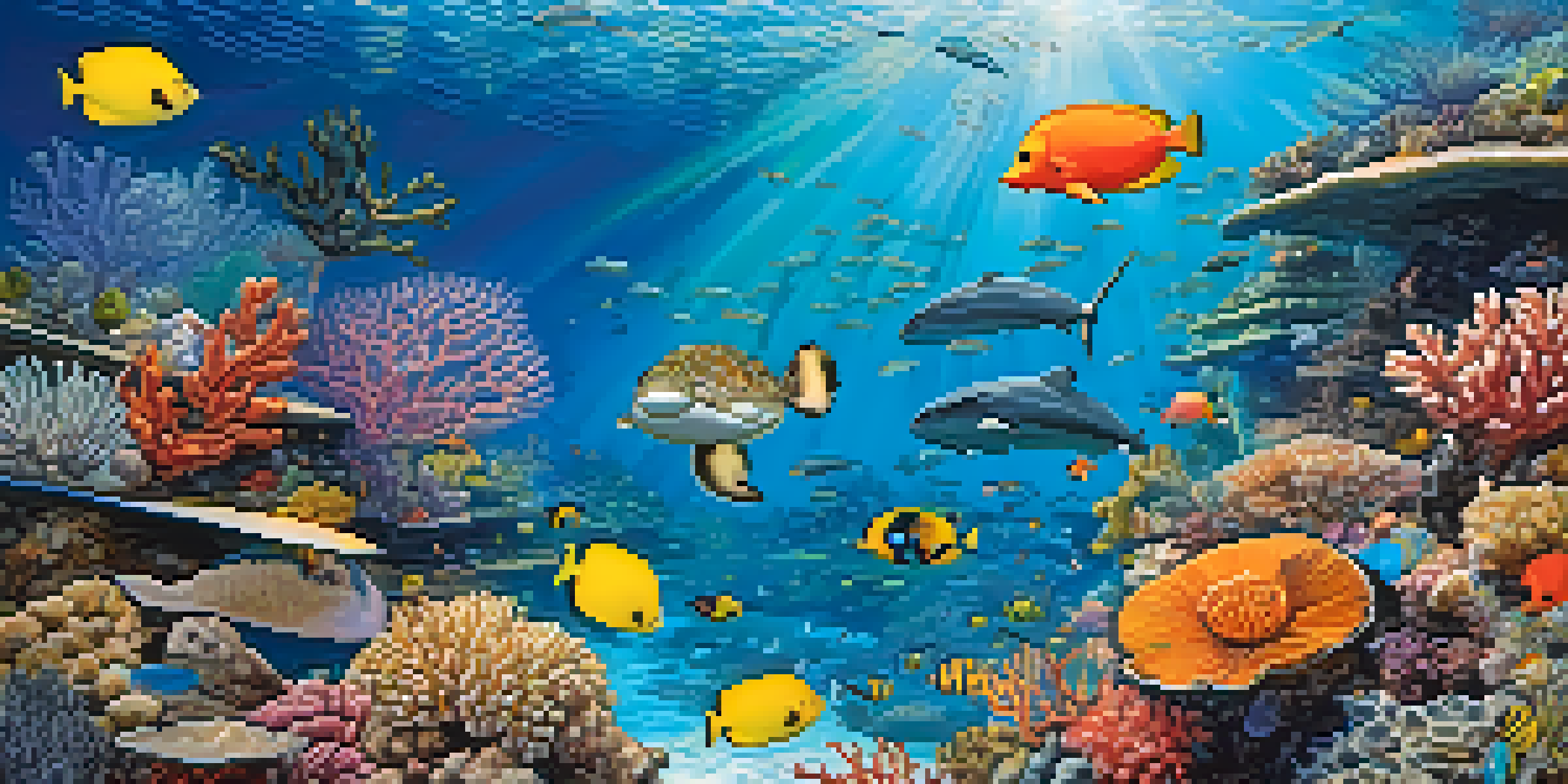The Importance of Marine Biodiversity Research in San Diego

Understanding Marine Biodiversity and Its Importance
Marine biodiversity refers to the variety of life forms in ocean ecosystems, including species, habitats, and ecological processes. In San Diego, this diversity is not just a scientific curiosity; it plays a key role in maintaining healthy ocean ecosystems. A rich variety of marine species supports food webs and contributes to the resilience of marine habitats against environmental changes.
The future will be shaped by how well we understand and protect our oceans and the life they hold.
For example, a vibrant marine ecosystem can better withstand stressors like pollution, climate change, and overfishing. When species diversity is high, ecosystems are more adaptable and can recover from disturbances more effectively. This adaptability is essential for maintaining the balance of ocean health, which directly impacts coastal communities and economies.
In San Diego, a region known for its stunning coastline and rich marine life, understanding this biodiversity is crucial. Researching marine biodiversity helps us comprehend the intricate relationships between species and their environments, ultimately guiding conservation efforts and sustainable practices that benefit both nature and society.
Economic Benefits of Marine Biodiversity Research
The economic implications of marine biodiversity research in San Diego are significant. Healthy marine ecosystems contribute to local economies through tourism, fishing, and recreation. By understanding the biodiversity within these systems, we can better manage resources and ensure their sustainability for future generations.

For instance, the fishing industry relies heavily on the health of marine species populations. Proper research allows for the implementation of regulations that prevent overfishing and promote sustainable practices, which in turn supports the livelihoods of local fishermen. This sustainable approach not only benefits the economy but also ensures that fish populations remain robust.
Marine Biodiversity Boosts Resilience
A rich variety of marine species enhances the adaptability of ecosystems, helping them withstand environmental stressors.
Moreover, San Diego's thriving tourism sector, particularly marine-related activities such as whale watching and diving, greatly depends on the health of its marine biodiversity. By investing in research, we not only protect these natural wonders but also enhance the overall visitor experience, creating a win-win situation for the environment and the economy.
The Role of Marine Biodiversity in Climate Resilience
Climate change poses a serious threat to marine ecosystems, and biodiversity research is key to understanding how these systems can adapt. Diverse marine life can better cope with changing conditions, such as rising ocean temperatures and acidification. This adaptability is crucial for maintaining the health of our oceans and, by extension, our planet.
In every drop of water, there is a story of life.
For example, coral reefs, which are incredibly biodiverse, act as buffers against storm surges and coastal erosion. By studying these ecosystems, researchers can develop strategies to protect and restore them, ultimately enhancing their resilience to climate impacts. In San Diego, where coastal development is prevalent, preserving these natural barriers is essential.
Furthermore, understanding the connections between marine biodiversity and climate resilience can inform policy decisions. By prioritizing the protection of diverse marine habitats, we can create a more sustainable future for coastal communities, ensuring they are better prepared for the challenges posed by climate change.
Conservation Efforts Fueled by Marine Biodiversity Research
Research into marine biodiversity is foundational for effective conservation efforts. In San Diego, scientists and conservationists work together to identify vulnerable species and habitats, guiding initiatives aimed at protecting these vital resources. This collaborative approach ensures that conservation strategies are informed by the latest scientific findings.
For instance, studies on local sea otter populations have led to enhanced protection measures that not only benefit the otters themselves but also the entire ecosystem they inhabit. By understanding the role of sea otters in maintaining kelp forests, researchers can advocate for policies that support both species and their habitats.
Economic Gains from Biodiversity
Understanding marine biodiversity supports sustainable practices that benefit local economies through tourism and fishing.
Moreover, biodiversity research helps raise public awareness about the importance of marine conservation. Engaging the community through educational programs and outreach can foster a sense of stewardship and encourage individuals to take action in protecting their local marine environments.
Community Involvement in Marine Biodiversity Research
Community involvement is a vital component of marine biodiversity research in San Diego. Local residents, educational institutions, and organizations often collaborate with researchers to gather data and monitor marine ecosystems. This participatory approach not only enhances research efforts but also fosters a deeper connection between the community and its marine environment.
For example, beach clean-up events and citizen science programs allow volunteers to collect valuable data while actively contributing to the health of local marine habitats. These hands-on experiences empower individuals to become advocates for marine conservation, fostering a culture of environmental responsibility in the community.
Additionally, involving the community in research initiatives can help bridge the gap between science and public understanding. By sharing findings and educating the community about the significance of marine biodiversity, we can inspire collective action to protect these precious resources for future generations.
Innovative Technologies in Marine Biodiversity Research
The advancement of technology has revolutionized marine biodiversity research, providing scientists with tools to study ecosystems more effectively. In San Diego, innovations such as remote sensing, underwater drones, and genetic analysis are enhancing our understanding of marine life and its complexities. These technologies allow researchers to gather data from hard-to-reach areas and monitor changes over time.
For instance, underwater drones can capture high-resolution images of coral reefs, revealing health status and biodiversity levels. This information is invaluable for developing targeted conservation strategies and assessing the effectiveness of ongoing efforts. As technology continues to evolve, its application in marine research promises to deliver even more insights.
Community Engagement is Crucial
Involving local residents in marine research fosters environmental stewardship and strengthens conservation efforts.
Furthermore, data collected through these innovative methods can inform policymakers and conservation organizations, ensuring that decisions are backed by solid scientific evidence. By integrating technology into marine biodiversity research, we can enhance our ability to protect and preserve these vital ecosystems.
Future Directions for Marine Biodiversity Research in San Diego
Looking ahead, the future of marine biodiversity research in San Diego is promising yet challenging. As we continue to face pressing issues like climate change and habitat loss, ongoing research will be necessary to adapt our conservation strategies. Future studies should focus on understanding the impacts of human activity on marine ecosystems and identifying ways to mitigate these effects.
Additionally, interdisciplinary approaches that integrate social sciences with biological research could provide a more holistic understanding of marine environments. By examining the social dimensions of marine conservation, researchers can develop strategies that resonate with local communities and garner broader support.

Ultimately, fostering collaboration between scientists, policymakers, and the public will be essential for the success of marine biodiversity research in San Diego. Together, we can work towards a sustainable future, ensuring that the rich marine biodiversity of this region is preserved for generations to come.